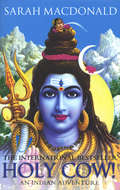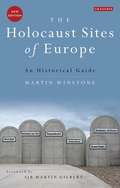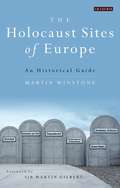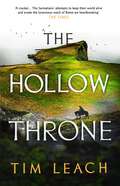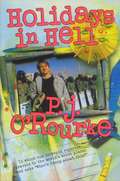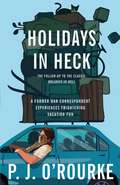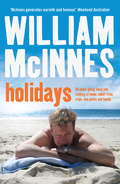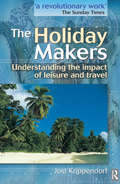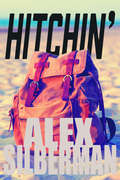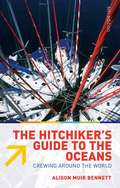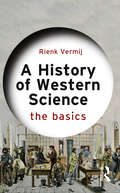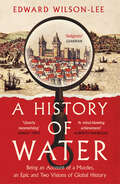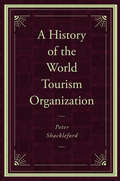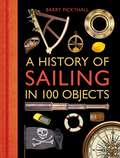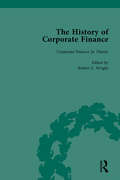- Table View
- List View
Holy Cow!: An Indian Adventure
by Sarah MacDonaldAfter backpacking her way around India, 21-year-old Sarah Macdonald decided that she hated this land of chaos and contradiction with a passion, and when an airport beggar read her palm and insisted she would come back one day - and for love - she vowed never to return. But twelve years later the prophecy comes true when her partner, ABC's South Asia correspondent, is posted to New Delhi, the most polluted city on earth. Having given up a blossoming radio career in Sydney to follow her new boyfriend to India, it seems like the ultimate sacrifice and it almost kills Sarah - literally. After being cursed by a sadhu smeared in human ashes, she nearly dies from double pheumonia. It's enough to send a rapidly balding atheist on a wild rollercoaster ride through India's many religions in search of the meaning of life and death. From the 'brain enema' of a meditation retreat in Dharamsala to the biggest Hindu festival on earth on the steps of the Ganges in Varanasi, and with the help of the Dalai Lama, a goddess of healing hugs and a couple of Bollywood stars - among many, many others - Sarah discovers a hell of a lot more.
The Holocaust Sites of Europe: An Historical Guide
by Martin WinstoneThe Holocaust - the murder of approximately six million Jews by Nazi Germany and its collaborators in World War Two - is the gravest crime in recorded history, committed on a human and geographical scale which is almost unimaginable. To try to bridge this gap and better understand the true significance of the Holocaust, as well as its scale and magnitude, millions of people each year now travel to the former camps, ghettos and other settings for the atrocities. The Holocaust Sites of Europe offers the first comprehensive guide to these sites, including much practical information as well as the historical context. It will be an indispensable guide for anyone seeking to add another layer to their understanding of the Holocaust by visiting these important sites for themselves. This guide includes a survey of all the major Holocaust sites in Europe, from Belgium and Belarus to Serbia and Ukraine.It includes not only the notorious concentration and death camps, such as Auschwitz and Ravensbruck, but also less well known examples, such as Sered' in Slovakia, together with detailed descriptions of massacre sites, as well as the ghettos, 'Euthanasia' centres and Roma and Sinti sites which witnessed similar crimes.Throughout the book there is also extensive reference to the many museums and memorials which commemorate the Holocaust. The Holocaust Sites of Europe is a thoughtful and fitting guide to some of the most traumatic sites in Europe and will be an invaluable companion for those who wish to honour the victims and to understand more about their fate. As the experience of the Holocaust recedes from living memory and the number of survivors (and perpetrators) diminishes with every passing year, these locations assume a greater importance as the principal physical reminders of what happened. Alongside the testimonies of survivors and the works of historians, the experience of, for example, exploring the vast ruins of Birkenau, or being shocked by the small area needed to kill nearly one million people at Treblinka, can bring another dimension to one's understanding.The Holocaust Sites of Europe is a thoughtful and fitting guide to some of the most traumatic sites in Europe and will be an invaluable companion for everyone who wants to honour the victims and to understand more about their fate.
The Holocaust Sites of Europe: An Historical Guide
by Martin WinstoneThe Holocaust - the murder of approximately six million Jews by Nazi Germany and its collaborators in World War Two - is the gravest crime in recorded history, committed on a human and geographical scale which is almost unimaginable. To try to bridge this gap and better understand the true significance of the Holocaust, as well as its scale and magnitude, millions of people each year now travel to the former camps, ghettos and other settings for the atrocities. The Holocaust Sites of Europe offers the first comprehensive guide to these sites, including much practical information as well as the historical context. It will be an indispensable guide for anyone seeking to add another layer to their understanding of the Holocaust by visiting these important sites for themselves. Thousands of locations across Europe were associated with the tragedy but, with a few well known exceptions, most languished in obscurity after the war, their names known only to survivors, perpetrators and a small number of historians. For over four decades the Iron Curtain served as a practical and psychological barrier to travel to the majority of the most significant sites. But now millions of people from all over the world are choosing to travel to Holocaust sites, whether for educational or familial reasons or simply out of respect for the dead. This guide includes a survey of all the major Holocaust sites in Europe, from Belgium and Belarus to Serbia and Ukraine. It includes not only the notorious concentration and death camps, such as Auschwitz and Ravensbrück, but also less well known examples, such as Sered' in Slovakia, together with detailed descriptions of massacre sites, ghettos, 'Euthanasia' centres and Roma and Sinti sites which witnessed similar crimes. Throughout the book there is also extensive reference to the many museums and memorials which commemorate the Holocaust.As the experience of the Holocaust recedes from living memory and the number of survivors (and perpetrators) diminishes with every passing year, these locations assume a greater importance as the principal physical reminders of what happened. Alongside the testimonies of survivors and the works of historians, the experience of, for example, exploring the vast ruins of Birkenau, or being shocked by the small area needed to kill nearly one million people at Treblinka, can bring another dimension to one's understanding. The Holocaust Sites of Europe is a thoughtful and fitting guide to some of the most traumatic sites in Europe and will be an invaluable companion for everyone who wants to honour the victims and to understand more about their fate.
The Hollow Throne: An epic adventure set in Roman Britannia (The Sarmatian Trilogy #3)
by Tim LeachThe unmissable conclusion to Tim Leach's critically acclaimed historical adventure series set in the Roman Empire.AD 180. Vindolanda, Britannia. Sarmatian warrior Kai and his adopted tribe, the Votadini, struggle for survival in unfamiliar lands north of the Wall, living just beyond the reach of Rome.When an old enemy takes control of the Votadini's hated foes, a confederation of tribes known as the Painted People, and rouses them to action, Kai heads south, hoping to ally with the Romans against this resurgent threat.But the Romans have heard tales of butchery and mayhem beyond the Wall. Lucius, Legate of the North, believes Kai and his allies are responsible, and sends forth an expedition to capture his old comrade.Can Kai survive the onslaught – or will such determined enemies spell the end for the warrior and his tribe?The Hollow Throne is perfect for fans of Bernard Cornwell and Adrian Goldsworthy.Reviews for Tim Leach:'Roman military adventure at its best.' Simon Turney 'The characters feel rounded and real, and the Sarmatians' attempts to keep their world alive and evade the tyrannous reach of Rome are heartbreaking.' The Times 'Tim Leach writes beautifully.' For Winter Nights 'Recommended.' Historical Novel Society 'Magnificent.' Historia 'A poetic, absorbing narrative.' Sunday Times
Holidays Then And Now (Collins Big Cat Ser. (PDF))
by Lucy George Collins StaffEveryone looks forward to their holidays. In this book you can learn how holidays began, and what they are like today. Orange/Band 6 books offer varied text and characters, with action sustained over several pages. Text type: An information text. Curriculum links: History: 'how people's lives have shaped this nation'. A timeline on pages 22-23 allows children to see the history of holidays in one neat summary. This book has been quizzed for Accelerated Reader.
Holidays in Hell
by P. J. O'RourkeNow available as an ebook, the original classic in which P.J. O'Rourke takes on the role of tour guide with hilarious resultsP.J. O'Rourke travels to hellholes around the globe in Holidays in Hell, looking for trouble, the truth, and a good time. After casually sight-seeing in war-torn Lebanon and being pepper-gassed in Korea, P.J. checks out the night life in communist Poland and spends the Christmas holidays in El Salvador. Taking a long look at Nicaragua, P.J. asks, "Is Nicaragua a Bulgaria with marimba bands or just a misunderstood Massachusetts with Cuban military advisors?"; has a close encounter with a Philippine army officer he describes as "powerful-looking in a short, compressed way, like an attack hamster"; and concludes, "Some people are worried about the difference between right and wrong. I'm worried about the difference between wrong and fun."'The first few pages of this book made me laugh so much I dropped it on my month-old baby... Holidays in Hell is a splendid read.' Evening Standard
Holidays in Heck
by P. J. O'RourkeHolidays in Heck takes the reader on a globe-trotting journey to far-reaching places including China, Kyrgyzstan, Afghanistan and the Galapagos Islands. The collection begins after the Iraq War, when P.J. retired from being a war correspondent because he was "too old to keep being scared stiff and too stiff to keep sleeping on the ground." Instead he embarked on supposedly more comfortable and allegedly less dangerous travels - often with family in tow - which mostly left him wishing he were under artillery fire again. The result is a hilarious and oftentimes moving portrait of life in the fast lane - only this time as a husband and father of three.Adventures include:- The first stag hunt in Britain after hunting had been banned. If the British had been half as caring about Indians and American colonists as they are about animals, they'd still rule the world.- A month-long tour of mainland China's economic hubs where P.J. learned that the entire Chinese concept of political freedom and individual liberty can be summed up in the words, 'New Buick'.- A harrowing horseback ride across the mountains of Kyrgyzstan - no towns, no roads, no people. "If something happened to my horse it would be shot. For me, the medical treatment wouldn't be that sophisticated."
Holidays: All About Going Away And Staying At Home, About Train Trips, Lion Parks And Family
by William McInnesFrom bestselling author William McInnes, a book about the languid, unending holidays of summer; it's about going away and staying at home, about sunburn, seagulls, family and friends.Remember those long, languid holidays when the only decisions to be made were what to pack in the Esky and who should get the front seat on the drive to the beach?Let William McInnes reignite your nostalgia for holidays past, and give you a taste of the boundless opportunities that await in holidays to come in this book about our love affair with life away from the everyday.This book will take you back to the holidays you had as a kid and remind you of the ones you've had with your own family or friends or even the ones where you've flown solo.Holidays are the runway to possibilities - a romantic sunset, the spare seat at breakfast being taken by an attractive stranger, a miraculous airline upgrade - or missing bags, unfortunate rashes and wrong turns that lead to places you definitely did not intend to go. Whether you are away from home and somewhere exotic or just in your own backyard on a lilo in an above-ground pool, whatever happens, you know that life is sweet because you're on HOLIDAYS.**Includes a bonus extract from William's hilarious and heartwarming memoir Fatherhood**"McInnes is a natural storyteller . . ." - Sun Herald, Sydney"McInnes enjoys a quirky love affair with the quintessential Australian holiday" - Brisbane News"Proves that the journey is just as agreeable as the destination" - Sunday Age". . . full of beautifully crafted childhood reminiscences and anecdotes" - Sunday Examiner"McInnes is a wonderfully engaging writer - witty and warm and a master of a good yarn. If your holidays aer a way off, curl up with William and he'll take you away" - Adelaide Advertiser
Holiday Makers: Understanding The Impact Of Leisure And Travel
by Jost KrippendorfThe Holiday Makers is thought-provoking and profound in its analysis of the present and future patterns of work and leisure. The author analyses the different forms of tourism, examines the effects on the indigenous countries and their people, and outlines positive steps to reconcile people's holiday requirements with the world's economic and social structures.
Holiday Makers
by Jost KrippendorfThe Holiday Makers is thought-provoking and profound in its analysis of the present and future patterns of work and leisure. The author analyses the different forms of tourism, examines the effects on the indigenous countries and their people, and outlines positive steps to reconcile people's holiday requirements with the world's economic and social structures.
HMS Victory (UEB uncontracted)
by RnibThis page shows an image of an old tall masted sailing ship. There is a locator dot shown, which will be at the top left, when the image is the correct way up. The front (bow) of the ship is on the left and the rear (stern) on the right. It is a side view of the ship. In the centre left of the page is the tip of the bowsprit. It is in three sections with the end of one section lashed to the beginning of the next section. It gets thicker closer to the ship. Down from the first section of the bowsprit at the front of the ship is the figurehead. This comprises two cupids supporting the royal coat of arms surmounted with the royal crown. Only one cupid would be seen from the side as the other cupid is on the other side of the ship. The figurehead is not shown in detail. Down and right are two small circles. These are holes through which the anchor rope would pass. The top half of the page is filled with masts and rigging. There are three masts, each formed of three sections like the bowsprit. Near the top of each bottom section is a small horizontal platform used as a lookout. Each mast has three crossbeams seen partly from the side so appear slightly diagonal. In reality they are perfectly horizontal and longer than shown. When not in use they would be at right angles to the ship's length. A rectangular sail would hang from each crossbeam and be tethered to the next lower crossbeam or, in the case of the lowest crossbeam, tethered to the deck. The mast on the right has an additional two beams going out to the right, one diagonal and one horizontal. When not in use they would be in line with the ship's length. They would support triangular mizzen sails. There are lots of ropes forming the rigging. They go from one mast to another, down to the deck, the bowsprit and two to the mizzen beams on the right. In reality there is a lot more rigging but this has not been shown for tactual clarity. The ship's hull fills the bottom of the page. In the middle of the top open deck are two lifeboats, a smaller one stacked on top of a larger one. At this level on the right of the ship are three gun ports. The black hatches could be opened and a canon could then fire at enemy ships. At the very end of the ship on the right are three floors of cabins. These were large relatively luxurious rooms. In the battle of Trafalgar they were used as private cabins by Nelson and Captain Hardy. The third room was a boardroom for officers. To the left are three rows of gun ports like the three in the top right of the hull. The wood around the gun ports running in three strips down the length of the hull are painted a bright cream colour. This gives a strong contrast to the black of the rest of the ship. This was done deliberately and other ships in the Royal Navy were painted with a similar colour scheme. It meant in a battle it was easy to tell friend from foe and prevent friendly fire . In the centre of the ship, middle of the middle row of gun ports, is a doorway. It has an elaborately carved gold door frame (details not shown). Down from, to the left and above the doorway are rungs giving access to the ship from the waterline. In the bottom right of the hull is a long thin rudder. Running across the bottom of the page is a dashed line. This represents the waterline.
HMS Victory (UEB contracted)
by RnibThis page shows an image of an old tall masted sailing ship. There is a locator dot shown, which will be at the top left, when the image is the correct way up. The front (bow) of the ship is on the left and the rear (stern) on the right. It is a side view of the ship. In the centre left of the page is the tip of the bowsprit. It is in three sections with the end of one section lashed to the beginning of the next section. It gets thicker closer to the ship. Down from the first section of the bowsprit at the front of the ship is the figurehead. This comprises two cupids supporting the royal coat of arms surmounted with the royal crown. Only one cupid would be seen from the side as the other cupid is on the other side of the ship. The figurehead is not shown in detail. Down and right are two small circles. These are holes through which the anchor rope would pass. The top half of the page is filled with masts and rigging. There are three masts, each formed of three sections like the bowsprit. Near the top of each bottom section is a small horizontal platform used as a lookout. Each mast has three crossbeams seen partly from the side so appear slightly diagonal. In reality they are perfectly horizontal and longer than shown. When not in use they would be at right angles to the ship's length. A rectangular sail would hang from each crossbeam and be tethered to the next lower crossbeam or, in the case of the lowest crossbeam, tethered to the deck. The mast on the right has an additional two beams going out to the right, one diagonal and one horizontal. When not in use they would be in line with the ship's length. They would support triangular mizzen sails. There are lots of ropes forming the rigging. They go from one mast to another, down to the deck, the bowsprit and two to the mizzen beams on the right. In reality there is a lot more rigging but this has not been shown for tactual clarity. The ship's hull fills the bottom of the page. In the middle of the top open deck are two lifeboats, a smaller one stacked on top of a larger one. At this level on the right of the ship are three gun ports. The black hatches could be opened and a canon could then fire at enemy ships. At the very end of the ship on the right are three floors of cabins. These were large relatively luxurious rooms. In the battle of Trafalgar they were used as private cabins by Nelson and Captain Hardy. The third room was a boardroom for officers. To the left are three rows of gun ports like the three in the top right of the hull. The wood around the gun ports running in three strips down the length of the hull are painted a bright cream colour. This gives a strong contrast to the black of the rest of the ship. This was done deliberately and other ships in the Royal Navy were painted with a similar colour scheme. It meant in a battle it was easy to tell friend from foe and prevent friendly fire . In the centre of the ship, middle of the middle row of gun ports, is a doorway. It has an elaborately carved gold door frame (details not shown). Down from, to the left and above the doorway are rungs giving access to the ship from the waterline. In the bottom right of the hull is a long thin rudder. Running across the bottom of the page is a dashed line. This represents the waterline.
HMS Victory (large print)
by RnibThis page shows an image of an old tall masted sailing ship. There is a locator dot shown, which will be at the top left, when the image is the correct way up. The front (bow) of the ship is on the left and the rear (stern) on the right. It is a side view of the ship. In the centre left of the page is the tip of the bowsprit. It is in three sections with the end of one section lashed to the beginning of the next section. It gets thicker closer to the ship. Down from the first section of the bowsprit at the front of the ship is the figurehead. This comprises two cupids supporting the royal coat of arms surmounted with the royal crown. Only one cupid would be seen from the side as the other cupid is on the other side of the ship. The figurehead is not shown in detail. Down and right are two small circles. These are holes through which the anchor rope would pass. The top half of the page is filled with masts and rigging. There are three masts, each formed of three sections like the bowsprit. Near the top of each bottom section is a small horizontal platform used as a lookout. Each mast has three crossbeams seen partly from the side so appear slightly diagonal. In reality they are perfectly horizontal and longer than shown. When not in use they would be at right angles to the ship's length. A rectangular sail would hang from each crossbeam and be tethered to the next lower crossbeam or, in the case of the lowest crossbeam, tethered to the deck. The mast on the right has an additional two beams going out to the right, one diagonal and one horizontal. When not in use they would be in line with the ship's length. They would support triangular mizzen sails. There are lots of ropes forming the rigging. They go from one mast to another, down to the deck, the bowsprit and two to the mizzen beams on the right. In reality there is a lot more rigging but this has not been shown for tactual clarity. The ship's hull fills the bottom of the page. In the middle of the top open deck are two lifeboats, a smaller one stacked on top of a larger one. At this level on the right of the ship are three gun ports. The black hatches could be opened and a canon could then fire at enemy ships. At the very end of the ship on the right are three floors of cabins. These were large relatively luxurious rooms. In the battle of Trafalgar they were used as private cabins by Nelson and Captain Hardy. The third room was a boardroom for officers. To the left are three rows of gun ports like the three in the top right of the hull. The wood around the gun ports running in three strips down the length of the hull are painted a bright cream colour. This gives a strong contrast to the black of the rest of the ship. This was done deliberately and other ships in the Royal Navy were painted with a similar colour scheme. It meant in a battle it was easy to tell friend from foe and prevent œfriendly fire . In the centre of the ship, middle of the middle row of gun ports, is a doorway. It has an elaborately carved gold door frame (details not shown). Down from, to the left and above the doorway are rungs giving access to the ship from the waterline. In the bottom right of the hull is a long thin rudder. Running across the bottom of the page is a dashed line. This represents the waterline.
Hitchin': A memoir
by Alex SilbermanIn 2015, when Alex Silberman was twenty-seven years old, he hitchhiked alone from East Coast America’s chilly Boston Harbor, north and west past Southern Ontario, before finally materializing from a desert mirage in California’s balmy Santa Cruz.Alex describes his colorful and often eye-opening experiences in transit, with an eclectic cast of characters willing to pick up a total stranger. Drawings, photographs, tips, tricks and anecdotes abound as Alex makes his way across the North American continent with just his wits and a thirst for adventure to keep him company. A frenzied man, a lovable donkey, families in conflict, unconventional relationships and even a handful of death threats pepper his life-affirming journey.Hitchin’ is a nostalgic tribute to the almost lost art of hitting the road and traveling for free (most of the time).Alex Silberman is an outdoor educator that has worked within and outside the United States.
The Hitchiker's Guide to the Oceans: Crewing Around the World
by Alison Muir BennettWhat better way of travelling the world than by crewing on a yacht? The Hitchiker's Guide to the Oceans is ideal for crew pre-planning, and for skippers seeking crew. It is packed with practical information from how to find a crew position, what to expect from different kinds of skipper, how to be in the right place at the right time, where the yachts gather and when, to rally locations, how to maximise your chances of being taken on as crew, what will be expected of you as crew, and job opportunities along the way. Unique yacht migration maps show where the seasonal bottlenecks occur, and help pinpoint the best places and times of year to gain a crew place. This sixth edition with fully updated information and website addresses as well as a new colour section will be welcomed by all aspiring yacht crew, and also as a skipper's reference. 'Packed with all the information you'd need to find a crewing position... an invaluable guide to crewing anywhere in the world.' Yachting Monthly'Valuable for the first-timer and useful for skippers and their potential crew.' Classic Boat
Hit Factories: A Journey Through the Industrial Cities of British Pop
by Karl WhitneyAfter discovering a derelict record plant on the edge of a northern English city, and hearing that it was once visited by David Bowie, Karl Whitney embarks upon a journey to explore the industrial cities of British pop music.Manchester, Liverpool, Newcastle, Leeds, Sheffield, Hull, Glasgow, Belfast, Birmingham, Coventry, Bristol: at various points in the past these cities have all had distinctive and highly identifiable sounds. But how did this happen? What circumstances enabled those sounds to emerge? How did each particular city - its history, its physical form, its accent - influence its music? How were these cities and their music different from each other? And what did they have in common?Hit Factories tells the story of British pop through the cities that shaped it, tracking down the places where music was performed, recorded and sold, and the people - the performers, entrepreneurs, songwriters, producers and fans - who made it all happen. From the venues and recording studios that occupied disused cinemas, churches and abandoned factories to the terraced houses and back rooms of pubs where bands first rehearsed, the terrain of British pop can be retraced with a map in hand and a head filled with music and its many myths.
A History of Western Science: The Basics (The Basics)
by Rienk VermijA History of Western Science: The Basics offers a short introduction to the history of Western science that is accessible to all through avoiding technical language and mathematical intricacies. A coherent narrative of how science developed in interaction with society over time is also provided in this comprehensive guide. The first part discusses the period up to 1700, with a focus on the conceptual shift and new ideas about nature that occurred in early modern Europe. Part two focusses on the practical and institutional aspects of the scientific enterprise and discusses how science established itself in Western society post 1700s, while part three discusses how during the same period modern science has impacted our general view of the world, and reviews some of the major discoveries and debates. Key topics discussed in the book include:• Natural philosophy, medicine, and mathematics in the ancient and medieval worlds• The key figures in the history of science—Galileo, Descartes, Isaac Newton, Darwin and Einstein—as well as lesser-known men and women who have developed the field• The development of scientific instruments, the transformation of alchemy into chemistry, weights and measures, the emergence of the modern hospital and its effects on medicine, and the systematic collection of data on meteorology, volcanism, and terrestrial magnetism• The big questions – the origins of humans, the nature of reality and the impact of science. As a jargon-free and comprehensive study of the history of Western science, this book is an essential introductory guide for academics and researchers of the history of science, as well as general readers interested in learning more about the field.
A History of Western Science: The Basics (The Basics)
by Rienk VermijA History of Western Science: The Basics offers a short introduction to the history of Western science that is accessible to all through avoiding technical language and mathematical intricacies. A coherent narrative of how science developed in interaction with society over time is also provided in this comprehensive guide. The first part discusses the period up to 1700, with a focus on the conceptual shift and new ideas about nature that occurred in early modern Europe. Part two focusses on the practical and institutional aspects of the scientific enterprise and discusses how science established itself in Western society post 1700s, while part three discusses how during the same period modern science has impacted our general view of the world, and reviews some of the major discoveries and debates. Key topics discussed in the book include:• Natural philosophy, medicine, and mathematics in the ancient and medieval worlds• The key figures in the history of science—Galileo, Descartes, Isaac Newton, Darwin and Einstein—as well as lesser-known men and women who have developed the field• The development of scientific instruments, the transformation of alchemy into chemistry, weights and measures, the emergence of the modern hospital and its effects on medicine, and the systematic collection of data on meteorology, volcanism, and terrestrial magnetism• The big questions – the origins of humans, the nature of reality and the impact of science. As a jargon-free and comprehensive study of the history of Western science, this book is an essential introductory guide for academics and researchers of the history of science, as well as general readers interested in learning more about the field.
A History of Water: Being An Account Of A Murder, An Epic And Two Visions Of Global History
by Edward Wilson-Lee‘Exhilarating and whip-smart’ THE SUNDAY TIMES ’A mind-blowing achievement’ ALBERTO MANGUEL
A History of the World Tourism Organization
by Peter ShacklefordTourism and travel have been with us since time immemorial. However, with the onset of the industrial age and the use of railways, ships, motorcars, and aeroplanes, travelling possibilities—for both business and pleasure, domestic and international—were transformed. The annals of the United Nations World Tourism Organization (UNWTO) provide us with unmatched insights into this fascinating story, yet these archives have never been exhaustively exploited. The History of the World Tourism Organization takes us on a unique journey to explain how tourism has burgeoned between the early twentieth century and now. Drawing on the UNWTO’s regularly published tourism statistics, this book provides comprehensive discussions of the consequences of an unhindered flow of tourists; the consequent protection of natural assets; the safeguarding of tourism resources; how frontier formalities affect this sector; how tourism impacts on world trade; and the promotion of tourism to countries in economic decline. Collectively, these investigations offer an impartial understanding of modern tourism and its effects. This definitive overview of this major intergovernmental organization is a must-read for students and scholars of tourism and hospitality, and it is of interest to anyone concerned with the past, present, and future of this ever-evolving and fundamentally human practice.
A History of the World Tourism Organization
by Peter ShacklefordTourism and travel have been with us since time immemorial. However, with the onset of the industrial age and the use of railways, ships, motorcars, and aeroplanes, travelling possibilities—for both business and pleasure, domestic and international—were transformed. The annals of the United Nations World Tourism Organization (UNWTO) provide us with unmatched insights into this fascinating story, yet these archives have never been exhaustively exploited. The History of the World Tourism Organization takes us on a unique journey to explain how tourism has burgeoned between the early twentieth century and now. Drawing on the UNWTO’s regularly published tourism statistics, this book provides comprehensive discussions of the consequences of an unhindered flow of tourists; the consequent protection of natural assets; the safeguarding of tourism resources; how frontier formalities affect this sector; how tourism impacts on world trade; and the promotion of tourism to countries in economic decline. Collectively, these investigations offer an impartial understanding of modern tourism and its effects. This definitive overview of this major intergovernmental organization is a must-read for students and scholars of tourism and hospitality, and it is of interest to anyone concerned with the past, present, and future of this ever-evolving and fundamentally human practice.
A History of Sailing in 100 Objects
by Barry PickthallDid you ever wonder which civilisation first took to water in small craft? Who worked out how to measure distance or plot a course at sea? Or why the humble lemon rose to such prominence in the diets of sailors?Taking one hundred objects that have been pivotal in the development of sailing and sailing boats, the book provides a fascinating insight into the history of sailing. From the earliest small boats, through magnificent Viking warships, to the technology that powers some of the most sophisticated modern yachts, the book also covers key developments such as keeps and navigational aids such as the astrolabe, sextant and compass. Other more apparently esoteric objects from all around the world are also included, including the importance of citrus fruit in the prevention of scurvy, scrimshaw made from whalebone and the meaning of sailor's tattoos.Beautifully illustrated with lively and insightful text, it's a perfect gift for the real or armchair sailor, the book gives an alternative insight into how and why we sail the way we do today.
A History of Sailing in 100 Objects
by Barry PickthallDid you ever wonder which civilisation first took to water in small craft? Who worked out how to measure distance or plot a course at sea? Or why the humble lemon rose to such prominence in the diets of sailors?Taking one hundred objects that have been pivotal in the development of sailing and sailing boats, the book provides a fascinating insight into the history of sailing. From the earliest small boats, through magnificent Viking warships, to the technology that powers some of the most sophisticated modern yachts, the book also covers key developments such as keeps and navigational aids such as the astrolabe, sextant and compass. Other more apparently esoteric objects from all around the world are also included, including the importance of citrus fruit in the prevention of scurvy, scrimshaw made from whalebone and the meaning of sailor's tattoos.Beautifully illustrated with lively and insightful text, it's a perfect gift for the real or armchair sailor, the book gives an alternative insight into how and why we sail the way we do today.
The History of Corporate Finance: Developments of Anglo-American Securities Markets, Financial Practices, Theories and Laws Vol 6
by Robert E Wright Richard SyllaThis work contains primary research texts regarding two centuries of the development of corporate finance in the US and Great Britain. It is designed to help scholars, financial managers, and public policymakers to investigate the historical background of issues in contemporary corporate finance.
The History of Corporate Finance: Developments of Anglo-American Securities Markets, Financial Practices, Theories and Laws Vol 6
by Robert E Wright Richard SyllaThis work contains primary research texts regarding two centuries of the development of corporate finance in the US and Great Britain. It is designed to help scholars, financial managers, and public policymakers to investigate the historical background of issues in contemporary corporate finance.
